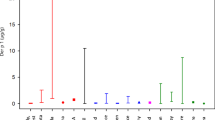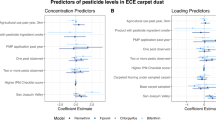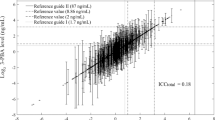Abstract
Children can be exposed to pesticides from numerous residential sources such as carpet, house dust, toys and clothing from treated homes, and flea control remedies on pets. In the present studies, 48 pet dogs (24 in each of two studies) of different breeds and weights were treated with over-the-counter flea collars containing chlorpyrifos (CP), an organophosphorus insecticide. Transferable insecticide residues were quantified on cotton gloves used to rub the dogs for 5 min and on cotton tee shirts worn by a child (Study 2 only). First morning urine samples were also obtained from adults and children in both studies for metabolite (3,5,6-trichloro-2-pyridinol) quantification. Blood samples were obtained from treated dogs in Study 1 and plasma cholinesterase (ChE) activity was monitored. Transferable residues on gloves for all compounds were highest near the neck of the dogs and were lowest in areas most distant from the neck. Rubbing samples (over the collar) at two weeks post-collar application contained 447±57 μg CP/glove while samples from the fur of the back contained 8±2 μg CP/glove. In Study 2, cotton tee shirts worn by children at 15 days post-collar application for 4 h showed CP levels of 134±66 ng/g shirt. There were significant differences between adults and children in the levels of urinary metabolites with children generally having higher urinary levels of metabolites than adults (grand mean±SE; 11.6±1.1 and 7.9±0.74 ng/mg creatinine for children and adults, respectively, compared to 9.4±0.8 and 6.9±0.5 ng/mg creatinine before collar placement). Therefore, there was little evidence that the use of this flea collar contributed to enhanced CP exposure of either children or adults.
This is a preview of subscription content, access via your institution
Access options
Subscribe to this journal
Receive 6 print issues and online access
$259.00 per year
only $43.17 per issue
Buy this article
- Purchase on Springer Link
- Instant access to full article PDF
Prices may be subject to local taxes which are calculated during checkout







Similar content being viewed by others
References
American Veterinary Medical Association. US Pet Ownership and Demographics Sourcebook 1997, Center for Information Management, American Veterinary Association: Schaumburg, Ill.
Barr D.B., Wilder L.C., Caudill S.P., Gonzalez A.J., Needham L.L., and Pirkle J.L. Urinary creatinine concentrations in the US population: implications for urinary biologic monitoring measurements. Environ Health Perspect 2005: 113: 192–200.
Barr D.B., and Angerer J. Potential uses of biomonitoring data: a case study using the organophosphorus pesticides chlorpyrifos and malathion. Environ Health Perspect 2006: 114: 1763–1769.
Boone J.S., Tyler J.T., Davis M.K., and Chambers J.E. Effects of topical phosmet on fur residue and cholinesterase activity of dogs. Toxicol Mech Meth 2006: 16: 275–280.
Boone J.S., Tyler J., and Chambers J.E. Transferable residues from dog fur and plasma cholinesterase inhibition in dogs treated with a flea control dip containing chlorpyrifos. Environ Health Perspect 2001: 109: 1109–1114.
Braitman L.E. Confidence intervals assess both clinical significance and statistical significance. Ann Intern Med 1991: 114: 515–517.
Castorina R., Bradman A., McKone T.E., Barr D.B., Harnly M.E., and Eskenazi B. Cumulative organophosphate pesticide exposure and risk assessment among pregnant women living in an agricultural community: a case study from the CHAMACOS cohort. Environ Health Perspect 2003: 111: 1640–1648.
Chambers H.W., and Chambers J.E. An investigation of acetylcholinesterase inhibition and aging and choline acetyltransferase activity following a high level acute exposure to paraoxon. Pest Biochem Physiol 1989: 33: 125–131.
Colt J.S., Lubin J., Camann D., Davis S., Cerhan J., Severson R.K., Cozen W., and Hartge P. Comparison of pesticide levels in carpet dust and self-reported pest treatment practices in four US sites. J Expos Anal Environ Epidemiol 2003: 14: 74–83.
Ellman G.L., Courtney K.D., Andres Jr V., and Featherstone R.M. A new and rapid colorimetric determination of acetylcholinesterase activity. Biochem Pharmacol 1961: 7: 88–95.
Fenske R.A., Black K.G., Elkner K.P., Lee C., Methner M.M., and Soto R. Potential exposure and health risks of infants following indoor residential pesticide applications. Am J Public Health 1990: 80: 689–693.
Fenske R.A., and Day Jr E.W. Assessment of exposure for pesticide handlers in agricultural, residential and institutional environments. In: Franklin CA, Worgan JP (Eds.) Occupational and Residential Exposure Assessment for Pesticides 2005, John Wiley and Sons Ltd., Hoboken, NJ, pp. 13–43.
Geer L.A., Cardello N., Dellarco M.J., Leighton T.J., Zendzian R.P., Roberts J.D., and Buckley T.J. Comparative analysis of passive dosimetry and biomonitoring for assessing chlorpyrifos exposure in pesticide workers. Ann Occup Hyg 2004: 48: 683–695.
Honeycutt R.C., Honeycutt M., DeGeare M., Day E.W., Houtman B., Chen G., Shurdut B.A., Nolan R.J., Vaccaro J.R., Murphy P., and Bartels M.J. Use of simultaneous biological monitoring and dermal dosimetry techniques to determine the exposure of chlorpyrifos to applicators and reentry workers. In: Honeycutt RC, Day EW, (eds.) Worker Exposure to Agrochemicals 2000, ACS Symposium Series. Baton Rouge. FL, USA: CRC, Lewis Publishers., pp. 21–34.
Hore P., Robson M., Freeman N., Zhang J., Wartenberg D., Ozkaynak H., Tulve N., Sheldon L., Needham L., Barr D., and Lioy P.J. Chlorpyrifos accumulation patterns for child-accessible surfaces and objects and urinary metabolite excretion by children for 2 weeks after crack-and-crevice application. Environ Health Perspect 2005: 113: 211–219.
Institute of Laboratory Animal Resources. Guide for the Care and Use of Laboratory Animals 1996, National Academy Press: Washington, DC.
Kissel J.C., Curl C.L., Kedan G., Lu C., Griffith W., Barr D.B., Needham L.L., and Fenske R.A. Comparison of organophosphorus pesticide metabolite levels in single and multiple daily urine samples collected from preschool children in Washington State. J Expos Anal Environ Epidemiol 2005: 15: 164–171.
Lowry O.H., Rosebrough N.J., Farr A.L., and Randall R.J. Protein measurement with Folin phenol reagent. J Biol Chem 1951: 193: 265–275.
Meuling W.J., Ravensberg L.C., Roza L., and van Hemmen J.J. Dermal absorption of chlorpyrifos in human volunteers. Int Arch Occup Environ Health 2005: 78: 44–50.
Morgan M.K., Stout II D.M., and Wilson N.K. Feasibility study of the potential for human exposure to pet-borne residues following lawn applications. Bull Environ Contam Toxicol 2001: 66: 295–300.
Nolan R.J., Rick D.L., Freshour N.L., and Saunders J.H. Chlorpyrifos: pharmacokinetics in human volunteers. Toxicol Appl Pharmacol 1984: 73: 8–15.
NRC. Pesticides in the Diets of Infants and Children 1993, National Academy Press: Washington, DC.
Rohrer C.A., Hieber T.E., Melnyk L.J., and Berry M.R. Transfer efficiencies of pesticides from household flooring surfaces to foods. J Expos Anal Environ Epidemiol 2003: 13: 454–464.
Shackelford D.D., Young D.L., Mihaliak C.A., Shurdut B.A., and Itak J.A. Practical immunochemical method for determination of 3,5,6-trichloro-2-pyridinol in human urine: applications and considerations for exposure assessment. J Agric Food Chem 1999: 47: 177–182.
USEPA. Organophosphate Pesticides in Food — Primer on Reassessment of Residue Limits 1999, Washington DC: United States Environmental Protection Agency.
Woody R.C. The clinical spectrum of pediatric organophosphate intoxications. Neurotoxicology 1984: 5: 75.
Acknowledgements
This research was supported by grants from the US Environmental Protection Agency's Science to Achieve Results (STAR) program (Grant Numbers R825170 and R828017). Although the research described in the article has been funded wholly or in part by the US Environmental Protection Agency's STAR program, it has not been subjected to any EPA review and therefore does not necessarily reflect the views of the Agency, and no official endorsement should be inferred. We thank Ms. Susan Waldrop, Ms. Nicole Holifield, Ms. Melissa Joyce, and Mr. Collin Zumwalt for assistance with cholinesterase assays and chemical analyses, and Dr. Carolyn Boyle for statistical advice. This research was also supported by the Mississippi Agriculture and Forestry Experiment Station (MAFES) and the College of Veterinary Medicine, Mississippi State University. This article is MAFES publication number J-11059 and the Center of Environmental Health Sciences publication number 111.
Author information
Authors and Affiliations
Corresponding author
Rights and permissions
About this article
Cite this article
Chambers, J., Boone, J., Davis, M. et al. Assessing transferable residues from intermittent exposure to flea control collars containing the organophosphate insecticide chlorpyrifos. J Expo Sci Environ Epidemiol 17, 656–666 (2007). https://doi.org/10.1038/sj.jes.7500570
Received:
Accepted:
Published:
Issue Date:
DOI: https://doi.org/10.1038/sj.jes.7500570
Keywords
This article is cited by
-
Assessing intermittent pesticide exposure from flea control collars containing the organophosphorus insecticide tetrachlorvinphos
Journal of Exposure Science & Environmental Epidemiology (2008)



